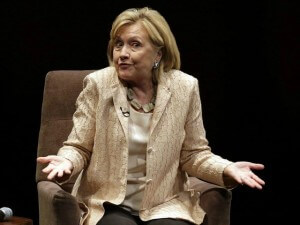'It's Not Classified Because it's Marked; It's Marked Because it's Classified'
It's not the Markins, Hillary.
By Charlie Martin
PJMedia.com
It appears now that Hillary Clinton’s main rhetorical defense against the increasing evidence that her private server contained classified information is that it wasn’t “marked classified.” A fair number of people have been repeating this as if it were somehow significant.
It’s not. Ron Fournier put it succinctly: Marked or not is irrelevant. Red herring.
It’s actually easy to see why. John Schindler did a nice worked example that I’ve linked before, showing how a document is marked; I’d recommend it to anyone. But the reasoning behind it is simple: some information, if released, would cause significant damage. Let’s say I’m working in the State Department, and I’m concerned with Elbonia. There are a number of sources that CIA can be feeding me, and State has its own resources. So, I may have stuff crossing my desk that says:
- The U.S. military attache was talking with his valet about the increasing number of Elbonians ordering military-style fur hats.
- The ambassador had a meeting with the head of the opposition party who tells him that there is a new super-secret program taking lots of money away from his pet project.
- The NSA is intercepting cell-phone calls from the prime minister of Elbonia to his minister of defense asking about progress on Project Guillaume Tell.
- Satellite imagery shows construction of a long straight railroad track with a 1500-meter curved construction at one end and a great big pulley at the other.
The analysts at CIA, and the person on the Elbonia Desk at State, might reasonably conclude there is a massive intercontinental ballistic crossbow program going on in Elbonia.
I can promise you that each of these memos is marked, as anything from “sensitive but unclassified” to TOP SECRET Talent Keyhole NOFORN. Our military attache knows that if he fails to do it, he’ll end up with a job even less desirable than being military attache in Elbonia, as difficult as such a job might be to imagine. But how does the military attache know to mark it?
The answer – and the derived authority that authorizes him to mark it – comes from Executive Order 13526, signed by President Barack Obama and issued on December 25, 2009, which says material should be classified when (Section 1.4):
[I]ts unauthorized disclosure could reasonably be expected to cause identifiable or describable damage to the national security in accordance with section 1.2 of this order, and it pertains to one or more of the following:
(a) military plans, weapons systems, or operations;
(b) foreign government information;
(c) intelligence activities (including covert action), intelligence sources or methods, or cryptology;
(d) foreign relations or foreign activities of the United States, including confidential sources;
(e) scientific, technological, or economic matters relating to the national security;
(f) United States Government programs for safeguarding nuclear materials or facilities;
(g) vulnerabilities or capabilities of systems, installations, infrastructures, projects, plans, or protection services relating to the national security; or
(h) the development, production, or use of weapons of mass destruction.”
I’ll leave it as an exercise for the interested reader to decide which clause applies to each item on my list of memos, except to note that the fact the leader of the opposition is talking with the ambassador is the sort of thing that could get the leader of the opposition found dead one morning, having committed suicide by shooting himself six times in the back of the head.
The thing is, knowing that the ambassador is meeting with the leader of the opposition isn’t sensitive because someone marked the papers – it’s sensitive because if word got around, it could get someone killed. The stuff from satellite imagery is sensitive because we don’t want people to know how good our imagery is. The cell-phone intercepts are sensitive because we don’t want the Elbonians to know we can listen to their cell phones. But it’s not sensitive because someone marked it – it’s sensitive because of what it is.


